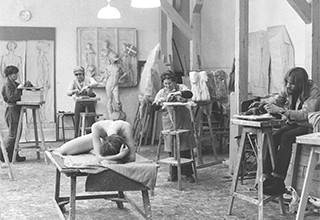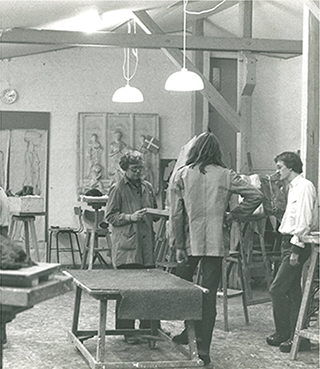
The story about the independent art school
The story about the Aarhus Academy of Fine Arts begins in 1960 when the Jutland Art Academy was founded. This was the first educational opportunity for young and ambitious emerging artists in Aarhus. The Academy was managed and run by the charismatic painter Kam Petersen.
From the very start, focus was on free access to the school. Everyone should have access to art education. Outside classes, discussions on art, philosophy, culture, etc. were plentiful among Academy students and teaching staff. There were both full-time and evening classes. Several of the students had – as they still do – ordinary jobs beside their studies. At Studsgade 29, where the Academy was located, students received tuition in painting, printmaking, sculpture, and ceramics. For various periods, tuition has been available in fine art batik, weaving, and graphic design.
A schism appears in the Jutland Art Academy
In 1964 a schism divided the Jutland Art Academy. The reason was disagreement on the future of this field of education – fuelled by personal differences between some members of the Board and the principal Kam Petersen. Kam Petersen wanted to continue as an independent art school under the auspices of the Adult Education Act while some members wanted to opt for a formal academy education based on entry requirements – along the lines of the one offered by the Royal Academy of Fine Arts in Copenhagen.
A break was inevitable – and the school was divided into two entities. The Jutland Art Academy kept the name and the student register while the Aarhus Academy of Fine Arts kept Kam Petersen, the phone, and the address. Aarhus Academy of Fine Arts emerged as a name during the summer of 1964.
The scandalous Kam Petersen
Kam Petersen remained principal until the early 1970s when he was strongly criticised for his daily drinking bouts, bad management, and private use of school funds. A great scandal followed in the wake of Kam Petersen’s dismissal and the ensuing court case, which Kam Petersen won. Eventually, a new principal was hired and school fees rose.
Vestergade 29
In 1971 the Aarhus Academy of Fine Arts rented some premises at Vestergade 29 following J.E. Schmalfeld moving his tobacco production out of the city centre. Everyone helped convert the buildings to a school of visual arts and crafts, and new departments of ceramics, weaving, and fine art batik were established. The City of Aarhus, headed by the mayor Thorkild Simonsen, purchased the buildings in 1975 and has since secured premises for the activities of the Aarhus Academy of Fine Arts.
Over the years, the Aarhus Academy of Fine Arts grew steadily – but has never compromised on its basic philosophy of a high-standard art education in terms of quality and pedagogy and a teaching staff consisting of professional artists. A fact appreciated by more than 1000 students a year. Learn more about our education .
The Aarhus Academy of Fine Arts is an association under the auspices of Folkeoplysningsloven (the Act on Non-Formal Education and Democratic Voluntary Activity) and, as such, open to anyone who would like to engage with the challenge of art. Today the Aarhus Academy of Fine Arts is a member of Dansk Oplysnings Forbund (the Danish Adult Education Association).

‘We would often be seated around the long table – with a blue oversized coffee pot in the middle and with Kam Pedersen as the unifying mentor and inspiring influence. With his black hair and beard and sparkling hypnotic eyes, he was a cross-breed between Christ and Rasputin. There were lively discussions – on art, culture, literature, society, and much else. Everything that stirred in the early 60s. We were young, we had hopes and faith in the future and in ourselves – mostly due to the energetic milieu of the place.’
Inge Rasmussen, student from 1960-64 and tutor from 1977-94.
‘I learned a lot about teaching from the tutors at the Aarhus Academy of Fine Arts: never to compromise on quality, to be able to assess artistic quality and distinguish it from gimmickry. That one can never immerse oneself too much. That the idea of time is irrelevant when making art. I would like to thank the school in Vestergade for all this – and be allowed to use it in my work with non-formal education in the years to come.’
Leo E. Andreasen, principal from 1972-80.

THE STORY BEHIND THE PREMISES
The Aarhus Academy of Fine Arts use the old premises that once housed the tobacco factories known as Den Funderske Tobaksfabrik and J.E. Schmalfeld tobaks- og cigarfabrik, respectively.
Den Funderske Tobaksfabrik
The factory was originally founded in 1802 by Peter Funder and occupied Vestergade 29. In 1870 the factory was taken over by J.E. Schmalfeld’s Fabrikker, who subsequently moved his operations to Vestergade 29. The main building with the gates opening to the yard originates from this time while the half-timbered house extending from it is much older. It can be dated back to around the 1600s.
J.E. Schmalfeld’s tobacco and cigar factory
At the corner of the main building of the Aarhus Academy of Fine Arts, the name SCHMALFELD can still be seen on the façade, and the rustic rooms contain several references to this era. Schmalfeld took over the premises in 1870 and the place was run as a tobacco factory until 1971 when Skandinavisk Tobakskompagni (Scandinavian Tobacco Company) took over the business. The actual factory then moved out of the heart of the city and the Aarhus Academy of Fine Arts moved in.
This background adds a rustic atmosphere to the Aarhus Academy of Fine Arts and the authentic surroundings from the time of the factory are a source of inspiration in itself, but the rooms are continuously altered and adapted to accommodate the needs of the teaching staff and practitioners of art. The classrooms, therefore, are up-to-date and well-equipped and their historic context contributes to a fantastic student environment.





